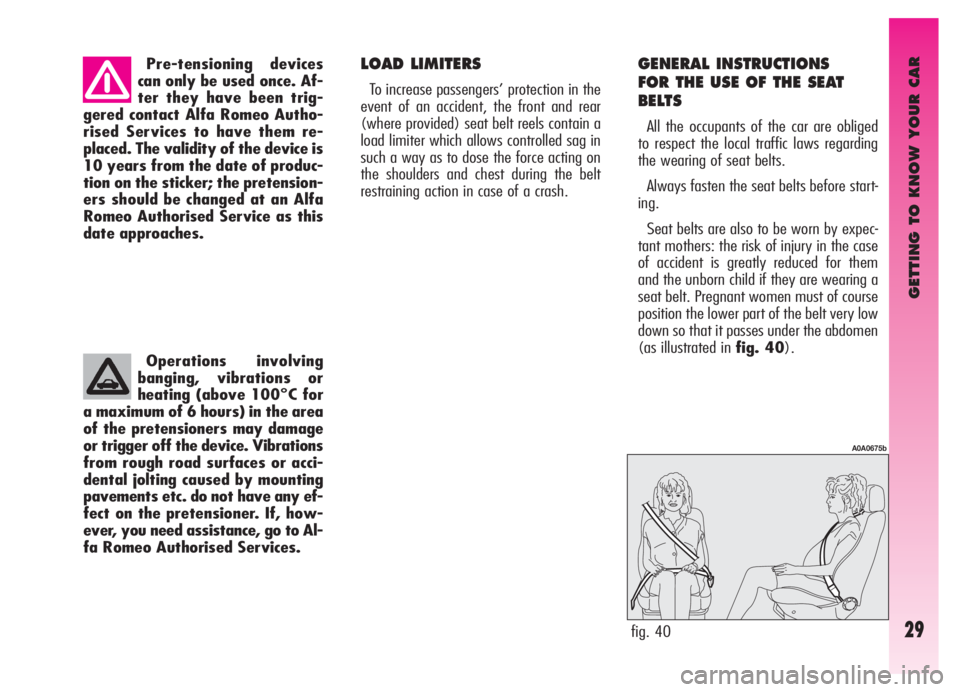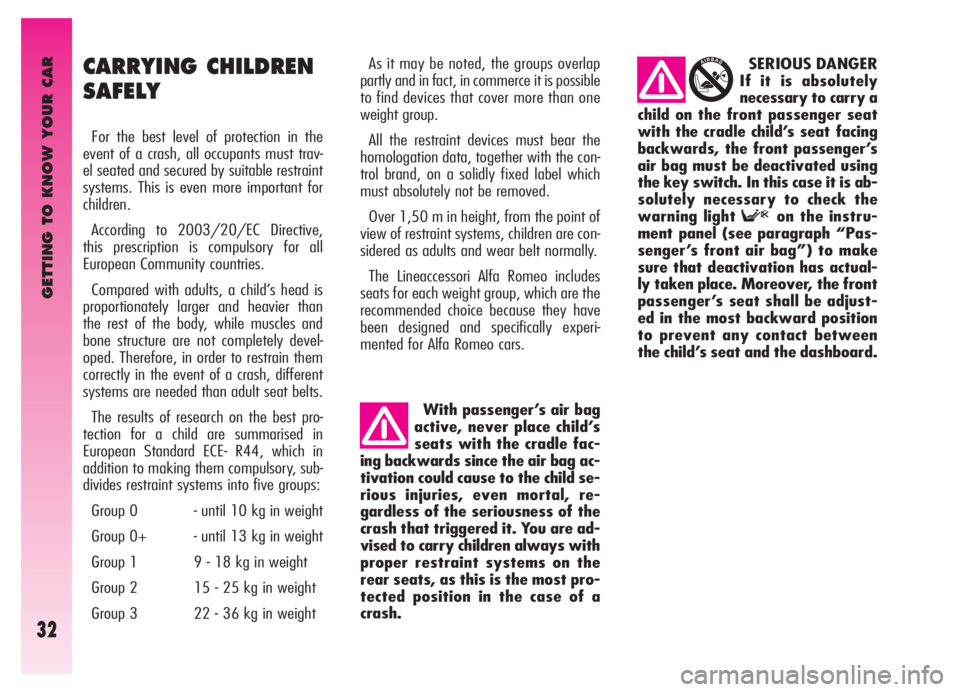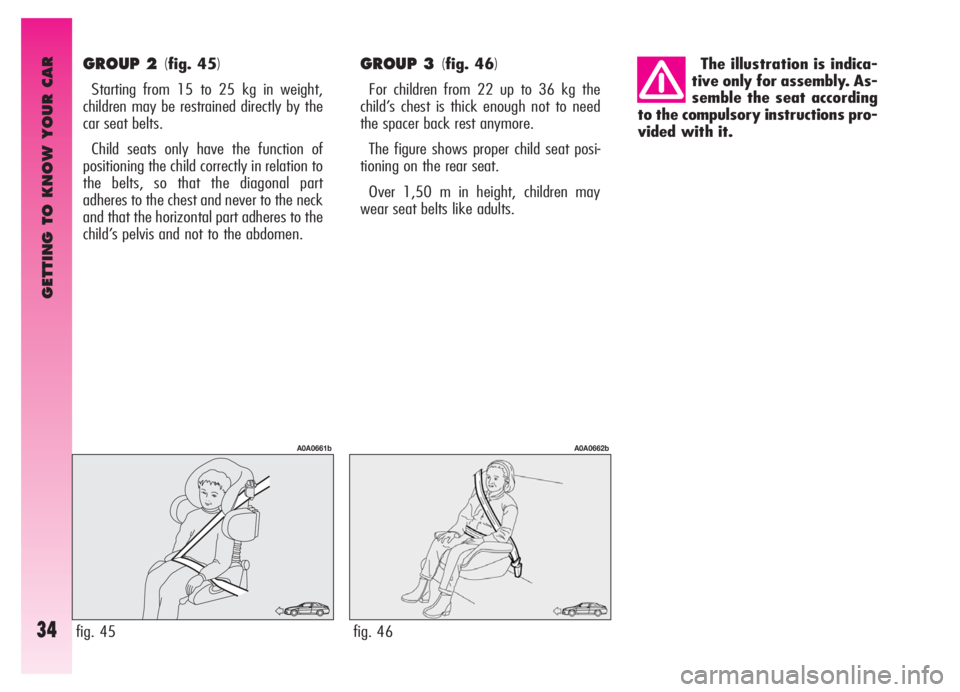Alfa Romeo GT 2005 Owner handbook (in English)
Manufacturer: ALFA ROMEO, Model Year: 2005, Model line: GT, Model: Alfa Romeo GT 2005Pages: 307, PDF Size: 6.05 MB
Page 31 of 307

GETTING TO KNOW YOUR CAR
29
Pre-tensioning devices
can only be used once. Af-
ter they have been trig-
gered contact Alfa Romeo Autho-
rised Services to have them re-
placed. The validity of the device is
10 years from the date of produc-
tion on the sticker; the pretension-
ers should be changed at an Alfa
Romeo Authorised Service as this
date approaches.
Operations involving
banging, vibrations or
heating (above 100°C for
a maximum of 6 hours) in the area
of the pretensioners may damage
or trigger off the device. Vibrations
from rough road surfaces or acci-
dental jolting caused by mounting
pavements etc. do not have any ef-
fect on the pretensioner. If, how-
ever, you need assistance, go to Al-
fa Romeo Authorised Services.
fig. 40
A0A0675b
LOAD LIMITERS
To increase passengers’ protection in the
event of an accident, the front and rear
(where provided) seat belt reels contain a
load limiter which allows controlled sag in
such a way as to dose the force acting on
the shoulders and chest during the belt
restraining action in case of a crash.
GENERAL INSTRUCTIONS
FOR THE USE OF THE SEAT
BELTS
All the occupants of the car are obliged
to respect the local traffic laws regarding
the wearing of seat belts.
Always fasten the seat belts before start-
ing.
Seat belts are also to be worn by expec-
tant mothers: the risk of injury in the case
of accident is greatly reduced for them
and the unborn child if they are wearing a
seat belt. Pregnant women must of course
position the lower part of the belt very low
down so that it passes under the abdomen
(as illustrated in fig. 40).
Page 32 of 307

Under no circumstances
should the components of
the seat belt and preten-
sioner be tampered with or re-
moved. Any operation should be
carried out by qualified and autho-
rised personnel. Always contact an
Alfa Romeo Authorised Service.
GETTING TO KNOW YOUR CAR
30
IMPORTANTThe seat belt must not be
twisted. The upper part must pass over the
shoulder and diagonally across the chest.
The lower part must rest across the pelvis
and not across the (fig. 41) stomach. Do
not use devices (clips, stoppers, etc.) which
keep the belts away from the body.To ensure the highest de-
gree of protection, you are
recommended to keep the
seat backrest in the straightest po-
sition possible, and the belt adher-
ing well to the chest and pelvis.
Seat belts should always be worn
in both the front and rear positions!
Travelling without seat belt in-
creases the risk of serious injury or
death in the case of accident.
fig. 41
A0A0673b
fig. 42
A0A0051b
IMPORTANT Each seat belt shall be
worn only by one person: do not carry chil-
dren on your knee using a single seat belt
for both (fig. 42). Do not fasten other
objects to the body.
Page 33 of 307

GETTING TO KNOW YOUR CAR
31
HOW TO KEEP THE SEAT BELTS
ALWAYS IN EFFICIENT
CONDITIONS
To keep the seat belts always in efficient
conditions, observe the following:
– always use the belts with the tape
well taut and never twisted; make sure
that it is free to run without impediments;
– after a serious accident, replace the
belt being worn at that time, even if it
does not appear damaged. Always replace
the seat belts if pretensioners have been
activated;
– to clean the belts, wash by hand with
neutral soap, rinse and leave to dry in the
shade. Never use string detergents, bleach
or dyes or any other chemical substance
that might weaken the fibres;– prevent the reels from getting wet:
correct operation of them is only guaran-
teed if water does not get inside;
– replace the seat belt if it shows signif-
icant wear or cut signs. If the seat belt has been
subjected to shock, for ex-
ample during an accident, it
must be completely replaced to-
gether with the attachments and
their screws, and the pretension-
ing devices, even if visible defects
are not detected, as the belt may
have lost its resilience.
Page 34 of 307

GETTING TO KNOW YOUR CAR
32
CARRYING CHILDREN
SAFELY
For the best level of protection in the
event of a crash, all occupants must trav-
el seated and secured by suitable restraint
systems. This is even more important for
children.
According to 2003/20/EC Directive,
this prescription is compulsory for all
European Community countries.
Compared with adults, a child’s head is
proportionately larger and heavier than
the rest of the body, while muscles and
bone structure are not completely devel-
oped. Therefore, in order to restrain them
correctly in the event of a crash, different
systems are needed than adult seat belts.
The results of research on the best pro-
tection for a child are summarised in
European Standard ECE- R44, which in
addition to making them compulsory, sub-
divides restraint systems into five groups:
Group 0 - until 10 kg in weight
Group 0+ - until 13 kg in weight
Group 1 9 - 18 kg in weight
Group 2 15 - 25 kg in weight
Group 3 22 - 36 kg in weightAs it may be noted, the groups overlap
partly and in fact, in commerce it is possible
to find devices that cover more than one
weight group.
All the restraint devices must bear the
homologation data, together with the con-
trol brand, on a solidly fixed label which
must absolutely not be removed.
Over 1,50 m in height, from the point of
view of restraint systems, children are con-
sidered as adults and wear belt normally.
The Lineaccessori Alfa Romeo includes
seats for each weight group, which are the
recommended choice because they have
been designed and specifically experi-
mented for Alfa Romeo cars.
With passenger’s air bag
active, never place child’s
seats with the cradle fac-
ing backwards since the air bag ac-
tivation could cause to the child se-
rious injuries, even mortal, re-
gardless of the seriousness of the
crash that triggered it. You are ad-
vised to carry children always with
proper restraint systems on the
rear seats, as this is the most pro-
tected position in the case of a
crash.SERIOUS DANGER
If it is absolutely
necessary to carry a
child on the front passenger seat
with the cradle child’s seat facing
backwards, the front passenger’s
air bag must be deactivated using
the key switch. In this case it is ab-
solutely necessary to check the
warning light Fon the instru-
ment panel (see paragraph “Pas-
senger’s front air bag”) to make
sure that deactivation has actual-
ly taken place. Moreover, the front
passenger’s seat shall be adjust-
ed in the most backward position
to prevent any contact between
the child’s seat and the dashboard.
Page 35 of 307

GETTING TO KNOW YOUR CAR
33
GROUP 0 AND 0+ (fig. 43)
Babies up to 13 kg must be carried fac-
ing behind on a cradle seat which, sup-
porting the head, does not induce strain
on the neck in the event of a sharp decel-
eration.
The cradle is restrained by the car safety
belts, as illustrated, and it should in turn
restrain the child with the belts incorporat-
ed on it.
GROUP 1 (fig. 44)
Starting from 9 to 18 kg in weight, chil-
dren may be carried facing forwards with
seats fitted with front cushion, through
which the car seat belt restrains both child
and seat.The illustration is indica-
tive only for assembly.
Assemble the seat accord-
ing to the compulsory instructions
provided with it.
Seats exist which are
suitable for covering
weight groups 0 and 1
with a rear connection to the car
belts and its own belts to
restrain the child. Because of
their mass, they can be danger-
ous if installed incorrectly fas-
tened to the car belts with a
cushion. Strictly adhere to the
assembly instructions provided.
fig. 43
A0A0659b
fig. 44
A0A0660b
Page 36 of 307

GETTING TO KNOW YOUR CAR
34
GROUP 2 (fig. 45)
Starting from 15 to 25 kg in weight,
children may be restrained directly by the
car seat belts.
Child seats only have the function of
positioning the child correctly in relation to
the belts, so that the diagonal part
adheres to the chest and never to the neck
and that the horizontal part adheres to the
child’s pelvis and not to the abdomen.
GROUP 3 (fig. 46)
For children from 22 up to 36 kg the
child’s chest is thick enough not to need
the spacer back rest anymore.
The figure shows proper child seat posi-
tioning on the rear seat.
Over 1,50 m in height, children may
wear seat belts like adults.The illustration is indica-
tive only for assembly. As-
semble the seat according
to the compulsory instructions pro-
vided with it.
fig. 45
A0A0661b
fig. 46
A0A0662b
Page 37 of 307

GETTING TO KNOW YOUR CAR
35
PASSENGER SEAT COMPLIANCE WITH REGULATIONS ON CHILD’S SEAT USE
The car omplies with the new EC Directive 2000/3 regulating child’s seat assembling on the different car seats according to the follow-
ing table:
Key:
U= suitable for child restraint systems of the “Universal category”, according to European Standard ECE-R44 for the specified “Group”.
Group
Group 0, 0+
Group 1
Group 2
Group 3
Range of weight
until 13 kg
9-18 kg
15-25 kg
22-36 kgFront
passenger
U
U
U
URear
passengers
U
U
U
UCentral
passenger
U
U
U
U
Page 38 of 307

GETTING TO KNOW YOUR CAR
36
Below is a summary of the safe-
ty rules to be observed when car-
rying children:
– The recommended position for
installing a child’s seat is on the rear seat,
as it is the most protected in the event of
a crash.
– If the passenger’s air bag is deactivat-
ed,alwayscheck the warning light
F
on the cluster to make sure that it has
actually been deactivated.
– Carefully follow the instructions pro-
vided with the child’s seat, which the sup-
plier is obliged to attach. Keep them in the
car together with the documents and this
booklet. Do not use used seats without
the instructions for use.
– Always pull the tape to check that
belts are buckled.With passenger’s air bag
active, never place child’s
seats with the cradle fac-
ing backwards since the air bag ac-
tivation could cause to the child se-
rious injuries, even mortal, re-
gardless of the seriousness of the
crash that triggered it. You are ad-
vised to carry children always with
proper restraint systems on the
rear seats, as this is the most pro-
tected position in the case of a
crash.– All restraint systems are strictly for one
child only: never use for two children at
the same time.
– Always make sure that the belts do
not rest on the child’s neck.
– During the journey, do not allow the
child to stay in abnormal positions or
release the belts.
– Do not carry children in your arms, not
even small babies. No-one, however
strong, can keep hold od them in a crash.
– In the case of accidents, replace the
child’s seat with a new one.
PRESETTING FOR
MOUNTING THE
“TYPE ISOFIX” CHILD
RESTRAINT SYSTEM
The vehicle is fitted with rear seat
arranged for mounting type Isofix child
restraint system, a European standardised
system for mounting child restraints. Type
Isofix is an additional option that does not
prevent from using traditional child
restraint systems. The type Isofix child’s
seat covers three weight groups: 0, 0+
and 1.
Due to its different anchoring system,
the type Isofix child’s seat shall be
anchored just using the metal brackets
(A-fig. 47) set between rear seat back
and cushion.
fig. 47
A0A0671b
Page 39 of 307

GETTING TO KNOW YOUR CAR
37
Mount the child restraint
system only with the car
stationary. The Isofix child
restraint system is properly an-
chored to the mounting brackets
when clicks are heard. In any case,
keep to the installation instructions
that must be provided by the child
restraint system Manufacturer.– push the child restraint system until
hearing the locking clicks;
– check proper locking by moving the
child’s seat with force: the built-in safety
mechanism actually inhibits proper cou-
pling with only one coupling locked.
It is possible to mount both the tradi-
tional restraint system and the type Isofix
one, one on the left and the other on the
right, for example.
Since sizes are different, it is possible to
install max two traditional child’s seats on
the rear seats, or two type Isofix child’s
seats. On the front passenger’s seat it is
possible to mount only traditional child’s
seats.
These child’s seats are recommended
since they have been designed and exper-
imented expressely for this car.
fig. 48
A0A0663b
FITTING THE TYPE ISOFIX
CHILD’S SEAT
Groups 0 and 0+
For children of the 0 and 0+ group
(babies up to 13 Kg), the child’s seat is
facing backwards and the child is restrained
by the child’s seat belts (D-fig. 48).
As the child grows, passing to weight
group 1, the child’s seat shall be fitted fac-
ing forwards.
For proper mounting proceed as follows:
– check whether the release lever (B) is
at rest position (inward);
– find the presetting brackets (A), then
position the child restraint system with the
fastening devices (C) aligned with the
brackets;
Page 40 of 307

GETTING TO KNOW YOUR CAR
38
Group 1
For proper mounting proceed as follows:
– check whether the release lever (B-
fig. 49) is at rest position (inward);
– find the presetting brackets (A), then
position the child restraint system with fas-
tening devices (C) aligned with the brack-
ets;
– push the child restraint system until
hearing the locking clicks;
– check proper locking by moving the
child’s seat with force: the built-in safety
mechanism actually inhibits improper cou-
pling with only one coupling locked.FRONT AND SIDE
AIR BAGS
The car is fitted with front air bags for
the driver and for the passenger (side
bags - window bags).
FRONT AIR BAGS
The front air bag (driver’s and passen-
ger’s) has been designed to protect the
occupants in the event of of head-on
crashes of medium-high severity by plac-
ing the cushion between the occupant and
the steering wheel or dashboard.
Front air bags are designed to protect
the car occupants in front crashes and
therefore non-activation in other types of
collisions (side collisions, rear-end shunts,
roll-overs, etc...) is not a system malfunc-
tion.
In the case of a crash, an electronic con-
trol unit, when necessary, triggers inflation
of the cushion.
The cushion inflates instantaneously, set-
ting itself between the body of the front
occupants and the structures that could
cause injury. The cushion then deflates
immediately afterwards. With this configuration, the child is
secured also by the car seat belt and by
the upper belt. To apply car seat belts to
child’s seat refer to the child’s seat hand-
book.
fig. 49
A0A0664b